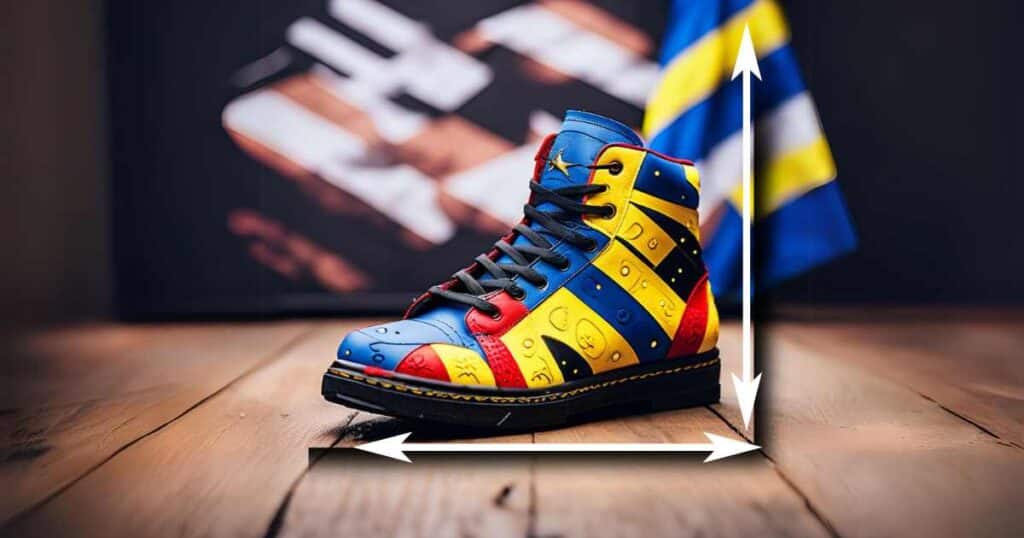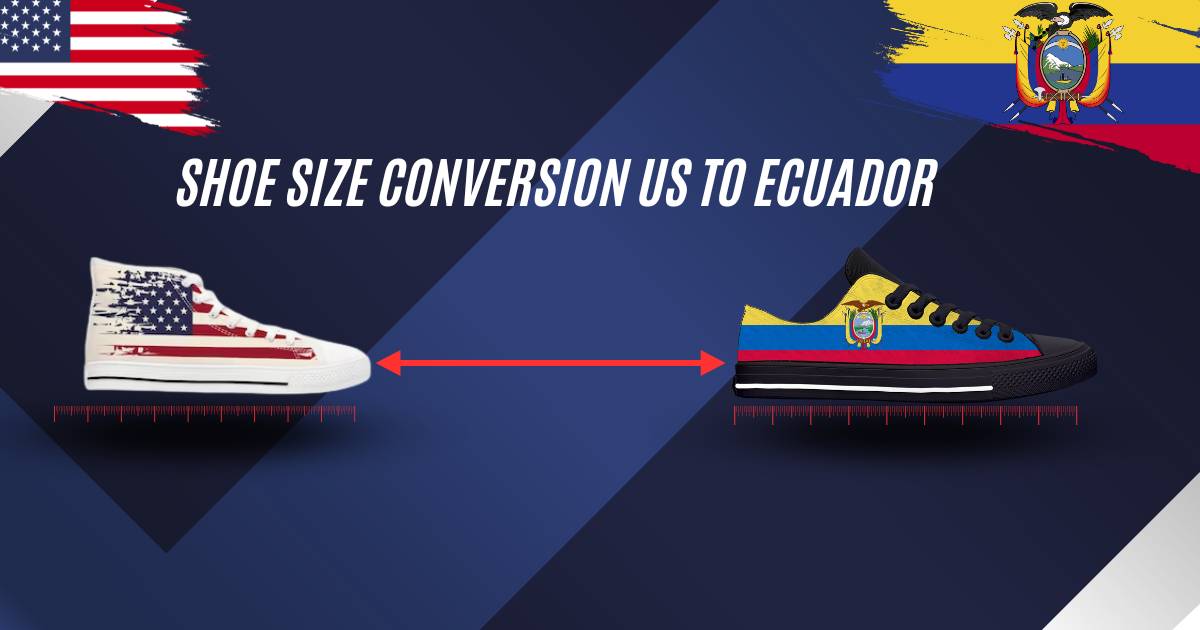Ever wondered how to match shoe sizes between the United States and Ecuador? Well, get ready for a simple solution! With just a glance at a conversion chart, you can easily switch between US and Ecuadorian shoe sizes. It’s like having a magic key to unlock the perfect fit for your feet, whether you’re wandering the streets of Los Angeles or exploring the markets of Quito. In Ecuador, shoe sizes tend to run one size smaller than in the US, so knowing this conversion trick is essential for hassle-free shoe shopping experiences. So, whether you’re planning a trip to Ecuador or just browsing online, mastering this
conversion will ensure your shoes fit like a glove every time. Let’s make shoe shopping a breeze, no matter where your adventures take you!
size of Ecuador compared to us table
Here are the shoe size conversion tables for men, women, and children from US to Ecuador using the Mondopoint system:
Men’s Shoe Size Conversion:
| US Size | Ecuador Size (Mondopoint) |
|---|---|
| 6 | 39 |
| 6.5 | 40 |
| 7 | 41 |
| 7.5 | 42 |
| 8 | 43 |
| 8.5 | 44 |
| 9 | 45 |
| 9.5 | 46 |
| 10 | 47 |
| 10.5 | 48 |
| 11 | 49 |
| 11.5 | 50 |
| 12 | 51 |
| 12.5 | 52 |
| 13 | 53 |
Women’s Shoe Size Conversion:
| US Size | Ecuador Size (Mondopoint) |
|---|---|
| 5 | 34 |
| 5.5 | 35 |
| 6 | 36 |
| 6.5 | 37 |
| 7 | 38 |
| 7.5 | 39 |
| 8 | 40 |
| 8.5 | 41 |
| 9 | 42 |
| 9.5 | 43 |
| 10 | 44 |
| 10.5 | 45 |
| 11 | 46 |
| 11.5 | 47 |
| 12 | 48 |
Children’s Shoe Size Conversion:
| US Size | Ecuador Size (Mondopoint) |
|---|---|
| 1C | 17 |
| 2C | 18 |
| 3C | 19 |
| 4C | 20 |
| 5C | 21 |
| 6C | 22 |
| 7C | 23 |
| 8C | 24 |
| 9C | 25 |
| 10C | 26 |
| 11C | 27 |
| 12C | 28 |
| 13C | 29 |
| 1Y | 30 |
| 2Y | 31 |
These tables serve as a general guide, and variations may exist between different brands and styles. Always consider brand and style differences, and refer to specific brand
Here are the shoe size conversion tables for men, women, and children from US to Ecuador using the Mondopoint system:
Understanding Shoe Size Conversion
When it comes to buying shoes internationally, it is crucial to understand shoe size conversion. Whether you are planning to buy shoes from the United States or Ecuador, knowing how to convert shoe sizes accurately can save you from the hassle of purchasing the wrong size. In this article, we will delve into the importance of shoe size conversion, the challenges involved, and the factors you should consider when converting shoe sizes.

Why Shoe Size Conversion Is Important
Buying shoes online has become a common practice worldwide. However, different countries use distinct sizing systems, causing confusion and inconvenience for customers. Understanding shoe size conversion is essential to ensure a perfect fit when purchasing shoes internationally. By converting shoe sizes accurately, you can avoid ordering the wrong size, which may lead to discomfort or the need for return and exchange.
Challenges In Shoe Size Conversion
Shoe size conversion is not always straightforward due to variations in measurement units and sizing scales used across different countries. Each country has its own unique shoe sizing system, making it challenging to find a direct match for your size. Additionally, shoe sizes can differ between brands and styles within the same country. These factors make it essential to have a clear understanding of shoe size conversion to make confident purchasing decisions.
Factors To Consider In Shoe Size Conversion
Effective shoe size conversion requires consideration of several factors to ensure an accurate fit. One crucial factor is the sizing system used in the country of origin and the destination country. For example, in the United States, shoe sizes are typically based on the Brannock Device measurements, while Ecuador follows the Mondopoint system. Another factor to consider is the gender-specific sizing differences that exist within each country’s system.
Furthermore, different shoe styles, such as athletic shoes, dress shoes, or boots, may have varying fit requirements. Understanding the specific characteristics of the shoe style and consulting brand-specific sizing charts can help you make informed decisions during the conversion process.
Lastly, it is important to keep in mind that individuals’ foot measurements can vary. Taking accurate foot measurements and comparing them to the corresponding size conversion charts can provide a more personalized fit and enhance your overall shoe-buying experience.
Converting Shoe Sizes From US to Ecuador

When it comes to shopping for shoes internationally, understanding shoe size conversions is crucial. If you’re planning to visit Ecuador, it’s important to know how to convert your US shoe size to the Ecuadorian shoe size system. In this article, we will provide an overview of the US shoe sizing system, help you understand Ecuadorian shoe sizes, and provide methods for converting US shoe sizes to Ecuadorian.
| US Size | Ecuador Size (Mondopoint) | Foot Length (mm) |
|---|---|---|
| 6 | 39 | 246.7 |
| 6.5 | 40 | 250.3 |
| 7 | 41 | 254.0 |
| 7.5 | 42 | 257.7 |
| 8 | 43 | 261.3 |
| 8.5 | 44 | 265.0 |
| 9 | 45 | 268.7 |
| 9.5 | 46 | 272.3 |
| 10 | 47 | 276.0 |
| 10.5 | 48 | 279.7 |
| 11 | 49 | 283.3 |
| 11.5 | 50 | 287.0 |
| 12 | 51 | 290.7 |
Overview Of US Shoe Sizing System
The US shoe sizing system is based on the length of the foot in inches. In this system, shoe sizes are typically measured in whole and half sizes for both men and women. The standard width for regular shoes is denoted as “B” for women and “D” for men. However, if you have wider feet, you might need to look for shoes with wider width options such as “C” or “E.”
Understanding Ecuadorian Shoe Sizes
Ecuador uses a different shoe sizing system compared to the US. The Ecuadorian shoe sizes are based on the Mondopoint system, which measures the length of the foot in millimeters. Ecuadorian shoes typically range from size 34 to 48 for adults. It’s important to note that Ecuadorian shoe sizes for children may differ from the adult sizes.
Converting US Shoe Sizes To Ecuadorian
Converting US shoe sizes to the Ecuadorian shoe size system can be done using a few simple methods. Here are the two most common methods:
- Use an Online Conversion Chart: Online conversion charts can be found on various shoe retail websites or specialized shoe size conversion websites. Simply input your US shoe size and let the chart provide you with the equivalent Ecuadorian shoe size. Keep in mind that different brands might have slight variations in their sizing, so it’s always recommended to check the specific brand’s conversion chart if available.
- Measure Your Feet in Millimeters: Another way to convert your US shoe size to Ecuadorian is by measuring your feet in millimeters. You can use a ruler or a measuring tape to measure the length of your foot. It’s important to measure both feet, as one foot might be slightly larger than the other. Once you have the measurements, refer to an Ecuadorian shoe size chart to find the corresponding size. Again, variations might exist among different shoe brands, so it’s best to consult the specific brand’s size chart if available.
Tips For Accurate Shoe Size Conversion
When it comes to buying shoes online or while traveling, accurate shoe size conversion is essential to ensure you get the perfect fit. Whether you are looking to convert your shoe size from US to Ecuador, understanding the key factors involved in this process can make a significant difference in your overall shopping experience.
Measuring Foot Length And Width
Measuring your foot length and width is the first step towards accurate shoe size conversion. To obtain the most precise results, follow these steps:
- Use a ruler or tape measure to measure the length of your foot, starting from the back of your heel to the tip of your longest toe. Make sure you stand on a level surface while measuring.
- Measure the width of the widest part of your foot using the same ruler or tape measure.
- Repeat the measurement for both feet, as they may have slightly different sizes.
Once you have these measurements, you can refer to a shoe size conversion chart to find your corresponding Ecuadorian size.
Using Size Conversion Charts
Size conversion charts act as a valuable resource when it comes to obtaining accurate shoe sizes in different countries. These charts provide a comparison between various international shoe sizing systems, making it easier for you to find the right size. To use a conversion chart:
- Locate the column for US shoe sizes and the row for Ecuadorian shoe sizes.
- Find the intersection of your measured foot length and width, and you will see the corresponding shoe size in Ecuadorian measurements.
Remember that conversion charts may vary slightly between brands, so it’s crucial to rely on the specific chart provided by the brand you are interested in purchasing from.
Considering Brand And Style Differences
While shoe size conversion charts provide a general guideline, it is important to consider brand and style differences that may affect the fit. Keep these points in mind:
- Some brands may have variations in sizing, so it’s recommended to review their size guide or customer reviews for specific insights.
- Shoe styles can also impact the fit. For example, a boot may have a different fit compared to a sneaker or a sandal. Take note of any information provided by the brand concerning the fit of the particular style you are interested in.
- If possible, try to visit a physical store to try on a pair of shoes from the brand or style you intend to buy online. This will give you a better sense of the fit and help you make a more accurate decision.
By considering these brand and style differences, you can further enhance the accuracy of your shoe size conversion and increase the likelihood of finding the perfect pair of shoes.
Conclusion
To sum up, understanding shoe size conversions between the US and Ecuador is essential when shopping internationally. By following the provided guidelines, you can easily navigate the differences and find the perfect fit for your feet. Remember to refer to a reliable conversion chart or consult with a knowledgeable expert to ensure accuracy.


